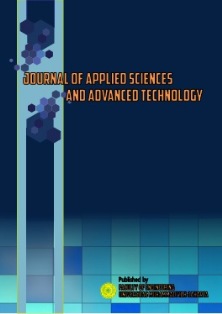Drying Of Microalgae Chlorella Sorokiniana on Antioxidant Activity and Formulation Application on Peel Off Gel Masker
DOI:
https://doi.org/10.24853/jasat.7.2.43-50Keywords:
C. sorokiniana, Drying, Antioxidant Activity, Microalgae, Peel Off Gel Mask.Abstract
Unhealty environmental conditions due to air pollution can cause the emergence of free radicals. Peel off gel mask is very practical and easy to apply mask by applaying evenly on the face and after draying, the mask can be removed immediately without the need to rinse. An alternative that can be chosen and is safe in overcoming skin problems is to use natural active inggridients, such as microalgae. Chlorella sorokiniana has nutritional conten, such as water content (6.54%), carbohydrates (18.08%), protein (46,80%), fat (19.93%), and minerals (7.3%). In addition, bioactive compound such as alkaloids, flavonoids, phenolics, saponins, and terpenoids. The purpose of this study was to dry microalgae C. sorokiniana at the best drying time conditions, testing proximate and bioacrtive compounds, such as total phenolics, flavonoids, and antioxidant activity, as well as formulating and evaluating C. sorokiniana microalgae powder mask preparations. The independent variabels in this study include the drying time of microalgae biomass C. sorokiniana 30, 60, 90, 120, and 150 minutes, as well as the concentration of microalgae powder C. sorokiniana 5, 10, 15, 20, 25% for the application of peel off gel mask preparations, while the dependent variables in this study include proximate content, total phenolic, total flavonoid, antioxidant activity, and evaluation of mask preparations. The procedures in this study include: cultivation, harvesting, and collection of microalgae biomass, drying process with time variations, proximate testing and bioactive compounds, as well as formulation and evaluation of C. sorokiniana microalgae powder mask preparations. The results showed that the best drying time for C. sorokiniana microalgae was 120 minutes with a constant drying rate. In proximate testing, including water content (9.27%), ash (4.28), carbohydrates (10.67%), fat (7.56%), protein (31.39%), and crude fiber (0.25%) which shows that the nutritional content of microalgae C. sorokiniana is quite high which can be used to nourish the skin. In addition, the total phenolic content (24.30 mgGAE/g), total flavonoids (19.70 mgQE/g), and antioxidant activity (543.79 mg/L) which shows the antioxidant content is very weak. In the evaluation of masks, organoleptic, pH, homogeneity, spreadability, dry time, and hedonic tests were carried out with 5 different formulations. Based on the evaluation results, the 4th formula has a formulation that meets the requirements and a high level of liking.Downloads
References
Ahmad, Z., & Darmayanti. (2018). Penuaan Kulit: Patofisiologi dan Manifestasi Klinis. Berkala Ilmu Kesehatan Kulit dan Kelamin – Periodical of Dermatology and Venereology, 30(03), 208-215.
Yudanto, F., Agustina, D., Romadloni, M. A., & Mu’tamar. (2022). Kajian Pembuatan Masker Wajah Organik Dari Campuran Ampas Kopi, Ampas Teh Hijau, Kunyit Dan Tepung Beras. Agroindustrial Technology Journal, 02(01), 91–97.
Annisa, A., Kawareng, A. T., & Indriyanti, N. (2021). Formulasi Sediaan Masker Gel Peel Off dari Minyak Atsiri Sereh (Cymbopogon citratus). Proceeding of Mulawarman Pharmaceuticals Conferences, 14, 348–353. https://doi.org/10.25026/mpc.v14i1.599
Rahmawanty, D., Yulianti, N., & Fitriana, M. (2015). Formulasi dan Evaluasi Masker Wajah Peel-Off Mengandung Kuersetin dengan Variasi Konsentrasi Gelatin dan Gliserin. Media Farmasi: Jurnal Ilmu Farmasi, 12(1), 17. https://doi.org/10.12928/mf.v12i1.3019
Budiman, A., Suyono, E. A., Dewayanto, N., Dewati, P. R., Pradana, Y. S., & Widawati, T. F. (2023). Biorefinery Mikroalga: Dari Mikroalga Menjadi Energi, Material, Komponen Aktif, Pangan, dan Pakan (Dewi Surani, Ed.). Gadjah Mada University Press.
Kumar, K., Dasgupta, C. N., & Das, D. (2014). Cell growth kinetics of Chlorella sorokiniana and nutritional values of its biomass. Bioresource Technology, 167, 358–366. https://doi.org/10.1016/j.biortech.2014.05.118
Susanty, D., & Oksari, A. A. (2020). Growth and secondary metabolites content of chloroform extract of Chlorella sp. and Chlorella sorokiniana cultured on chicken broiler waste media. Nusantara Bioscience, 12(1), 28–32. https://doi.org/10.13057/nusbiosci/n120105
Mursandi, H., Susanty, D., Nurhayati, L., & Oksari, A. D. E. A. Y. U. (2022a). Short Communication : Antioxidant activity of ethanol extract of Chlorella sorokiniana cultured in tofu wastewater. 14(2), 155–159. https://doi.org/10.13057/nusbiosci/n140204
Haji, A. T. S., Sutan, W, J. B. R., & Khotimah, M. (2018). Desain Fungsional GREEN ROOF ALGAE Sebagai Media Kultivasi Mikroalga ( Chlorella sp ) dengan Nutrien Limbah Cair Industri Tahu. Jurnal Keteknikan Pertanian Tropis Dan Biosistem, 6(1), 79–89.
Yulianti, N. O., & Hendrawati, T. Y. (2022). Effect of Drying Time , Anting-Anting Plant ( Acalypha Indica L .) Powder as Prepared by an Ultrasonic-Assisted Extraction. November, 1–6.
Fauzi, R. A., Widyasanti, A., Dwiratna Nur Perwitasari, S., & Nurhasanah, S. (2022). Optimasi Proses Pengeringan Terhadap Aktivitas Antioksidan Bunga Telang (Clitoria ternatea) Menggunakan Metode Respon Permukaan. Jurnal Teknologi Pertanian, 23(1), 9–22. https://doi.org/10.21776/ub.jtp.2022.023.01.2
Candraningsih, A., Hidayati Fithriyah, N., Yuni Hendrawati, T.. (2022). Proses Pengeringan Dan Ekstraksi Ultrasonik Daun Kersen (Muntingia Calabura L.) Sebagai Antioksidan Potensial. https://doi.org/10.24853/jurtek.14.2.247-254
Supraptiah, E., Ningsih, A. S., Zurohaina. (2019). Optimasi Temperatur dan Waktu Pengeringan Mi Kering yang Berbahan Baku Tepung Jagung dan Tepung Terigu. Jurnal Kinetika, 10(02), 42-47. https://jurnal.polsri.ac.id/index.php/kimia/index
Fikriyah, Y. U., & Nasution, R. S. (2021). Analisis kadar air dan kadar abu pada teh hitam yang dijual di pasaran dengan menggunakan metode gravimetri. AMINA, 3(2), 50–54.
Abreu, A. P., Martins, R., & Nunes, J. (2023). Emerging Applications of Chlorella sp. and Spirulina (Arthrospira) sp. In Bioengineering (Vol. 10, Issue 8). Multidisciplinary Digital Publishing Institute (MDPI). https://doi.org/10.3390/bioengineering10080955
Kim, J. H., Lee, J. E., Kim, K. H., & Kang, N. J. (2018). Beneficial effects of marine algae-derived carbohydrates for skin health. In Marine Drugs (Vol. 16, Issue 11). MDPI AG. https://doi.org/10.3390/md16110459
Kurniawati, I. F., & Sutoyo, S. (2021a). Article Review: The Potention Of Breadfuit Flowers (Artocarpus Altilis [Park. I] Fosberg) As Natural Antioxidant. UNESA Journal of Chemistry , 10(1).
Pradhan, B., Patra, S., Dash, S. R., Nayak, R., Behera, C., & Jena, M. (2021). Evaluation of the anti-bacterial activity of methanolic extract of Chlorella vulgaris Beyerinck [Beijerinck] with special reference to antioxidant modulation. Future Journal of Pharmaceutical Sciences, 7(1). https://doi.org/10.1186/s43094-020-00172-5
De, F., Neves, F., Demarco, M., & Tribuzi, G. (2019). Drying and Quality of Microalgal Powders for Human Alimentation. Microalgae - From Physiology to Application. www.intechopen.com
Ali, F., Stevani, H., & Rachmawaty, D. (2019). Formulasi Dan Stabilitas Sediaan Body Scrub Bedda Lotong dengan Variasi Konsentrasi Trietanolamin. Media Farmasi, 15(1), 71. https://doi.org/10.32382/mf.v15i1.852
Downloads
Published
Issue
Section
License
COPYRIGHT POLICY
The author(s) of an article published in the Journal of Applied Sciences and Advanced Technology (JASAT) retains ownership of the intellectual property rights in work (s).
PUBLISHING RIGHTS
The author(s) of an article published in the Journal of Applied Sciences and Advanced Technology (JASAT) have unrestricted publication rights. The authors give the Journal of Applied Sciences and Advanced Technology (JASAT) the right to publish the article and designate the Faculty of Engineering Universitas Muhammadiyah Jakarta Publishing as the original publisher of the article.
LICENSING POLICY
JASAT is an open-access journal that follows the Creative Commons Non-Commercial 4.0 International License (CC BY-NC 4.0), which states that:

Under this license, the reusers must give appropriate credit, provide a link to the license, and indicate if changes were made. Users may do so in any reasonable manner, but not in any way that suggests the licensor endorses users or their use.
Please take the time to read the whole license agreement (https://creativecommons.org/licenses/by-nc/4.0/). As long as reusers follow the license conditions, the owner cannot withdraw these freedoms. The following components are included under this license:
 Attribution: Users must provide appropriate attribution, including a link to the license, and indicate whether or not they made any modifications. Users are free to do so reasonably, but not in a manner that indicates the licensee approves of their usage.
Attribution: Users must provide appropriate attribution, including a link to the license, and indicate whether or not they made any modifications. Users are free to do so reasonably, but not in a manner that indicates the licensee approves of their usage.
 NonCommercial: Users may not use the material for commercial purposes.
NonCommercial: Users may not use the material for commercial purposes.












_2.png)


1.png)

2.png)
